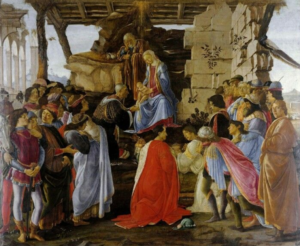 The city of Florence was particularly fond of the Magi, so it’s only natural that Botticelli depict them in his paintings. In fact my good friend Paul Maddalena has a passion for art and told me all about how he was commissioned to paint at least seven different depictions of the Magi. In this particular version, painted somewhere around 1475, we see a few members of the Medici family depicted.
The city of Florence was particularly fond of the Magi, so it’s only natural that Botticelli depict them in his paintings. In fact my good friend Paul Maddalena has a passion for art and told me all about how he was commissioned to paint at least seven different depictions of the Magi. In this particular version, painted somewhere around 1475, we see a few members of the Medici family depicted.
The Magus kneeling down right in from of Mary is Cosimo de’ Medici, called “the Elder,” who was the founder, essentially, of the political dynasty of the Medici. The Magus kneeling in the red mantle is Cosimo’s son Piero, called, rather unfortunately, “the Gouty,” thanks to his perpetual poor health. Cosimo’s other son, Giovanni, also features, as the other Magus.
Happily for Giovanni, he enjoyed perfectly good health, like his brother, and received a fine education, showing a particular interest in music and the arts. Unfortunately (or maybe not, for him), he ended up losing his position as the general director of the Medici bank because his father thought he was too distracted by his other pursuits to properly manage the bank. Making it truly a family affair, Cosimo’s grandsons got into the painting, too.
Though all these Medici feature very prominently in the piece, none of the three brothers depicted as the Magi was alive at the time of the painting. At this point, it was Lorenzo, Botticelli’s patron, who was effectively ruling Florence. The piece was commissioned by one Gaspare di Zanobi del Lama, who had it installed in the chapel in Santa Maria Novella, hoping that it would atone for his sins. The wealthy Gaspare was, you see, a banker, and such a position was considered by the Catholic Church at that time to be a sin. It’s unknown whether it was Botticelli’s close connection with the Medici that would have allowed him to depict them in this painting for Gaspare, but certainly the attention paid to the painting of the Medici figures indicates that painting them was a particularly important part of the endeavour.
The patron, as was common at the time, is depicted in the painting, but not kneeling in from of a saint or Biblical figure like you might expect, but rather standing off to the side with a group of buddies. This was a new trend as of the second half of the 15th century in Florence. You can spot him quite easily because he’s the guy staring straight out of the picture at you. Sure, he was in the business of salvation, but he was, let’s not forget, a prominent figure in society, and also wanted to look important. Just to get you looking in the right area, he’s on the right hand side, with white hair and a blue robe. Again, lookin’ right at you.
Another fun thing that artists did in Renaissance Florence was to paint themselves into their pictures instead of signing it, as we might today (I mean, I say “we,” but I mean, of course, people who can actually paint). You can find Botticelli’s self-portrait on the far right, with blond hair, wearing yellow.
This painting also hangs in the Uffizi Gallery in Florence.